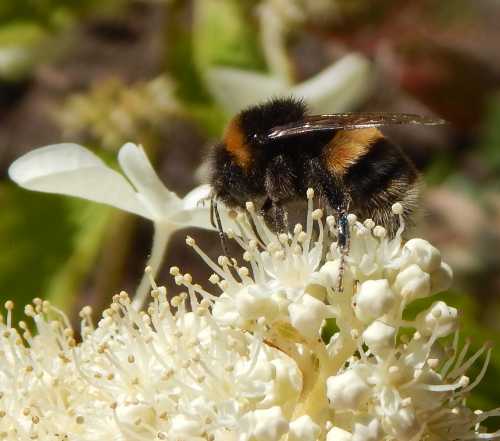Bees Foraging On Eryngium
Updated: 1st May 2021
I love the jewel blue of Eryngium flowers, and I especially
love to watch bees foraging on Eryngium, not to mention the other insects that
are attracted to this flowering plant, including hoverflies and butterflies.
At least some Eryngium varieties are commonly referred to as
‘sea holly’. Indeed, my favourite place of
all to observe bees foraging on Eryngium is around the coast, where the sea
holly adds lovely splashes of blue against the grasses and the sand.
Growing Eryngium for bees
There are plenty of cultivated varieties. In the photograph below, the Eryngium is a cultivated variety (although I'm not sure of the name). It's growing in a public garden. It had smaller flower heads than that growing wild by the coast, but was very popular with bees and hoverflies.
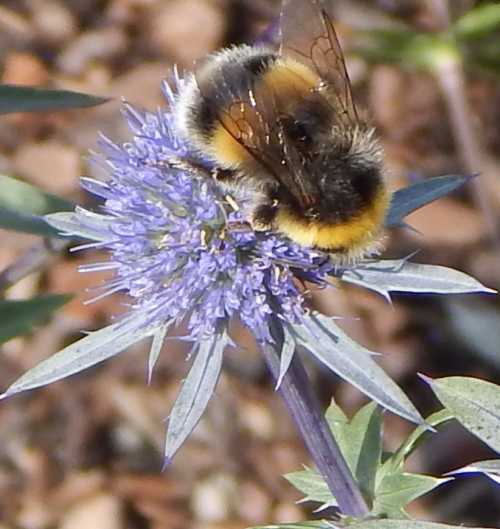 Bombus lucorum - white-tailed bumble bee - foraging on Eryngium.
Bombus lucorum - white-tailed bumble bee - foraging on Eryngium.This lovely plant is very pretty, and can tolerate exposed sites, fairly severe winters, and dry conditions. It likes full sun though. It also likes sandy soil, but will also thrive in loam or chalk (check the variety for suitability in your garden). You can grow it from seed.
I don’t have any experience with this, but my sister certainly has grown it, with great success. Once the flowers have gone over, she cuts some of the stems, dries them, and sprays them silver for decorations at Christmas time.
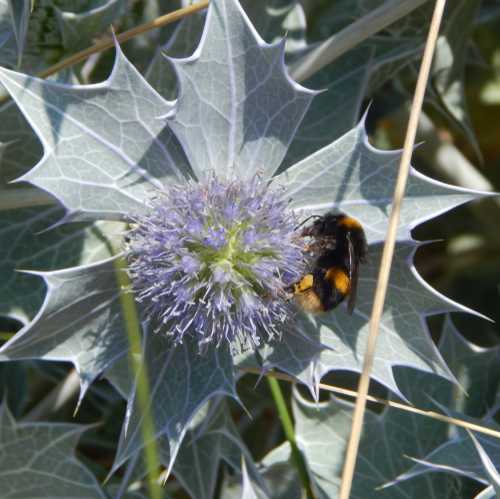 Bombus terrestris - buff-tailed bumble bee on sea holly - Eryngium maritimum.
Bombus terrestris - buff-tailed bumble bee on sea holly - Eryngium maritimum.
If you wish to grow it in your garden, some varieties may be
less susceptible to pests and diseases than others, so it’s worth checking.
Although I do not grow it myself currently, this is primarily down to lack of space in my garden, and since it grows in abundance locally I prefer to focus on growing other beneficial plants. Nevertheless, it is a plant I would recommend for bees.
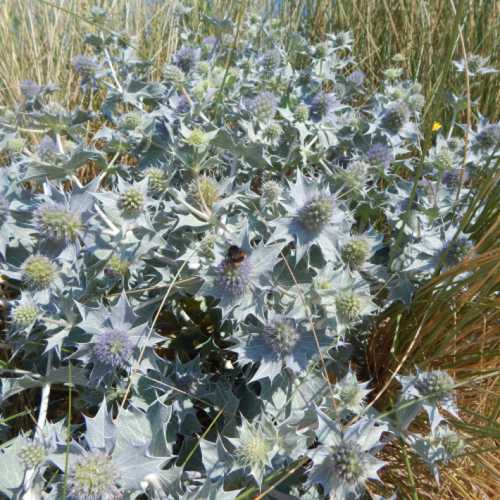 I love to see jewel blue sea holly among the clumps of grass along the coast. Bees like the sea holly too!
I love to see jewel blue sea holly among the clumps of grass along the coast. Bees like the sea holly too!
Which types of bees forage on Eryngium?
In my experience, this plant really has broad appeal for pollinators generally.
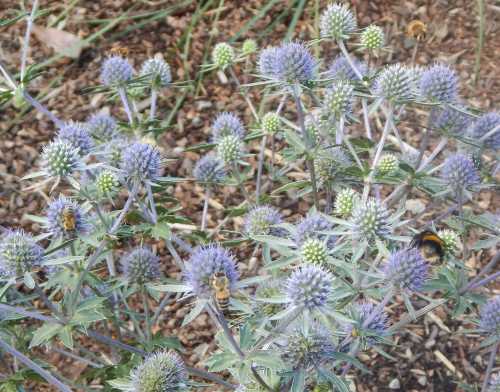 On this photograph there are 2 honey bees (to the left), a bumble bee in the foreground, and a hoverfly at the top right of the image (in flight).
On this photograph there are 2 honey bees (to the left), a bumble bee in the foreground, and a hoverfly at the top right of the image (in flight).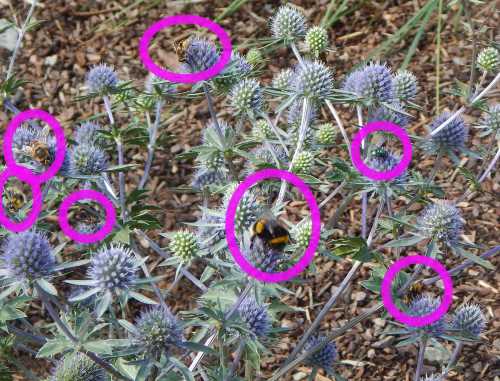 Cultivated varieties of Eryngium are available, and are attractive to bees and other pollinators. On this image alone there are 7 bees and flies.
Cultivated varieties of Eryngium are available, and are attractive to bees and other pollinators. On this image alone there are 7 bees and flies.I
have seen plenty of bumble bee species foraging on eryngium, as well as honey
bees and various solitary species, such as the coastal leafcutter bee.
Which varieties of Eryngium are best for bees?
I could be wrong, but believe most are great.
However, I list a few here for your consideration. They are taken from the RHS list of Eryngium earmarked as being attractive to bees. I have added Eryngium maritimum myself to this list, as this appears to be the specimen I see growing wild along the coast.
However, I cannot say for sure which of these varieties is the most attractive to pollinators.
- Eryngium maritimum
- Eryngium 'Cobalt Star'
- Eryngium × tripartitum
- Eryngium planum 'Bethlehem'
- Eryngium planum 'Blue Hobbit'
- Eryngium 'Blue Jackpot'
- Eryngium planum 'Blaukappe'
- Eryngium alpinum
For something a little different you could even try Eryngium giganteum 'Silver Ghost', which is a pale, whitish variety,
and is quite tall.
- Bees & Poppies Bees & poppies: bees love foraging on poppies for pollen - especially the Opium Poppy - Papaver somniferum
- Bees Love Zinnia Bees Love Zinnia. These beautiful flowers available in a variety of gorgeous jewel shades are a magnet for bees and other pollinators
. - Pulmonaria Officinalis - A Wonderful Early Flowering Plant For Bees Pulmonaria Officinalis - A Wonderful Early Flowering Plant For Bees - attracts bumblebees and hairy footed flower bees and is easy to grow
If you found this page helpful or interesting, I'd really be grateful if you would share it with others - if not this page, perhaps another, such as Gardening For Bees.
Thank you so much :) .
